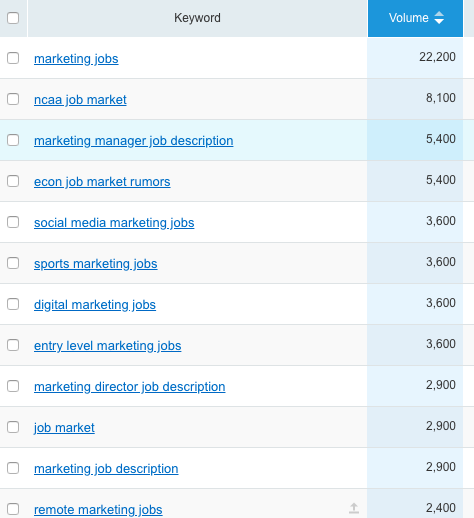Researching and utilizing the right keywords for your business is crucial to the success of your website. However, to increase your rankings and website conversions, you need more than a list of single keywords to make that happen. That’s where long-tail keywords come in.
Understanding Long-Tail Keywords
Long-tail keywords, as the name suggests, are longer, more specific keywords targeted to what your business is selling and typically range from three to four keyword phrases. These keyword phrases are commonly used in long-tail SEO practices to increase rankings, visibility, and conversions since they target keywords used by visitors who are closer to a point of purchase.
Examples of Long-Tail Keywords
To get a better idea of what a long-tail keyword looks like, here’s an example. We’ve used “marketing jobs” as the primary term. Listed below are additional, long-tail keywords related to that topic that can be used for SEO purposes.

Benefits Of Long-Tail Keywords
Long-tail keywords account for approximately 70% of web searches and lead to better conversions, making them essential to an effective SEO strategy. But that’s not all!
Here are seven other benefits they offer that you should consider:
1. They Can Help Outrank Competition
As we’ve discussed, long-tail keywords are more specific keyword terms. Because of this, they aren’t searched as often. However, as a result, you will rank better and get more qualified leads using them. Moreover, there is less competition for long-tail keywords which makes it easier for you to rank well. Plus, despite long-tail keywords being used less in search engines, a visitor who found your website using long-tail keywords is more likely to purchase your product or service.
2. It Is How People Use The Internet
People use the internet to search for things. And, it’s probably how they will find your business – or your competitors. That’s why using long-tail keywords is so important. The more descriptive you are, the more likely you’ll show up in searches and ahead of the rest. Just remember, you need to keep it relevant. You want visitors that will convert, so make sure you’re attracting the right audience.
3. Contribute To Mobile Site Optimization
These days, more and more people rely on their smartphones to search for the products and services they need, leaving their laptops behind. That’s why it’s crucial for your website to be optimized for mobile users. And it’s more than just design. You also have to consider your SEO.
Google’s latest search engine algorithm, Hummingbird, has adjusted search algorithms such that it matches the exact keyword phrasing more frequently and deepens their understanding of the context. In other words, Google is now focused more on long-tail keywords and in strengthening their search results, and you need to keep this in mind when you start planning your keyword campaign.
4. Better Conversion Rates
Recent research by WordStream suggests that the top 10% of landing pages have a conversion rate of 11.45%. Meanwhile, the conversion rate for long-tail keywords average is 36%. Why? Because long-tail keywords solidify the CRO funnel via organic search traffic. Plus, it is much easier to conduct research on these long-tail keyword terms and write related blog posts instead of paying for a PPC campaign for every keyword.
5. Help You With Your Blog Strategy
You may already be aware that blogging is the best method of ranking in SERPs. In fact, it should be the cornerstone of your content marketing strategy. For effectiveness, long-tail keywords must be used in the right context within the title tag, URL, meta description, and throughout the body text as well. For increased visibility, you can use the focus keyword in headers and alt images which optimizes your website for SEO. The question is, “How do long-tail keywords help with blogs?”.
Focusing on a single keyword minimizes your chances of ranking, and being found, for specific terms related to your focus keyword. For example, consider the long-tail keywords we provided as examples above. We selected the focus keyword, “marketing jobs”. How many blog topics can you develop from that? Not many.
However, using the other long-tail keywords we discovered, you have the potential to write several other related blog posts which will offer more value to your visitors.
Here are a few examples:
- 10 Best Entry-Level Marketing Jobs
- 8 Things You Need to Know Before Applying for Social Media Marketing Jobs
- Top 5 Things You Should Consider before Applying for a Remote Marketing Job
As you can see, the topics are specific and use long-tail keywords. If you need assistance in researching long-tail keywords, try using Google Keyword Planner.
6. Builds A Strong Conversion Tunnel
When you blog using long-tail keywords, you have the opportunity to build out a conversion funnel. One of the top marketing challenges that companies face today is generating leads and traffic. In fact, a survey conducted by HubSpot found that approximately 65% of companies are worried about the challenge. The primary reason behind this is the fact that the company’s content marketing strategies are not linked to a proper conversion funnel.
Remember that while ranking for your products is great, providing valuable content which will serve to help solve your potential buyers’ problems is crucial to creating conversions. It’s a great way to build trust and show them you know you are an expert in your field. Each customer will turn to you at a different point in the sales funnel, and your goal is to direct them through the right path to convince them to buy. Creating a library of useful content is a great way to maximize your SEO and conversions. Be sure to blog regularly about topics that your audience wants to read and include long-tail keywords so they can find you.
7. Answer Voice Assistant Searches
The concept of SEO is generally applied to inquiries made using search engines like Google. However, with voice assistants such as Apple’s Siri and Amazon’s Alexa, that has all changed. Numbers suggest that there are more than 8.3 million Echo smart speakers on the market, while the total voice assistant market, including Apple Home and Google Home, is expected to exceed 30 million soon.
Where do long-tail keywords come into the picture? Well, these specific keyword terms are used to train voice assistants so they can provide users with accurate information.
What to Do Next?
If you haven’t used long-tail keywords in your SEO strategy or don’t believe you’ve used them correctly, today is the day to make a change. Schedule some time to analyze your efforts and see where you can improve. Begin researching long-term keywords and develop a list of blog posts and start publishing one a week. See where it goes. Continue to analyze your rankings and analytics. Make adjustments. And if you have any questions, reach out and let us know. Best of luck!


